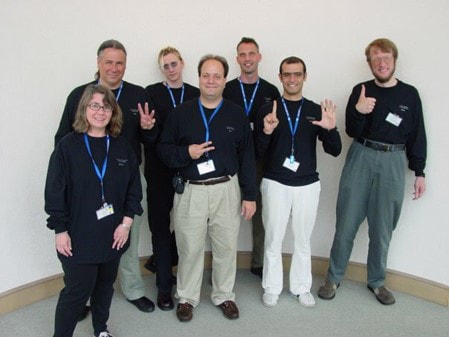June of 2022 marks the twentieth anniversary – yes – TWENTIETH – of the publication of the Session Initiation Protocol (SIP), documented in RFC 3261. When it was published in June of 2002, it set records for the longest specification produced by the Internet Engineering Task Force (IETF), at 269 pages. The IETF produces the technology standards that make the Internet work. Protocols like IP, TCP and HTTP – all now part of mainstream vernacular – came out of the IETF. It was a monumental effort to produce, involving a dedicated author team (shown below) that worked full time for months to ensure that the specifications were correct, consistent and complete. I had the great fortune to be the lead author of this document, an accomplishment which was the defining moment for my career.
In the 20 years (and almost countless extensions to SIP) that followed, it is hard to dispute that SIP has been a major success. At its core, SIP enabled the transformation of the telecommunications industry from one based on hardware, to one based on software – colloquially known as Voice over IP (VoIP). A 20th anniversary is the ideal time for a retrospective, to consider both its positives and negatives. On the plus side, this transformation resulted in the re-engineering of the phone network, the creation of new markets and market categories, and the creation of jobs and livelihoods. On the negative side, it has exacerbated the scourge of robocalling.
The Phone Network Re-Engineered
Prior to SIP, the telephone network was built using telephone switches based on custom hardware. These switches were made by a small set of vendors and were a completely verticalized solution from the physical networking layer to the application layer software.
With the mainstream adoption of IP networks, it became possible to replace that hardware with general purpose computers running SIP based software applications. This resulted a dramatic reduction of cost compared to the prior generation. SIP further reduced this cost by enabling these software applications to run on machines in a small number of data centers that might be far away from the people talking to each other, while still keeping the audio delays to a minimum. This centralization of the software was a dramatic shift in how the phone network worked.
This new paradigm had the most immediate impacts on the way corporate phone systems were built. Before SIP, businesses needed to put hardware based phone systems (called Private Branch Exchanges or PBXs) in each building, and wire them up on a separate network from the IP network used for everything else. SIP allowed enterprise IT departments to ditch this separate network and reuse the IP network for voice. It also allowed them to put the software in their data centers, and eliminate the hardware in each building. This was a huge improvement in costs and reduction in complexity. The final icing on the cake was that SIP enabled video, instant messaging and presence too. This spawned the creation of desktop applications – called softphones – which allowed users to place calls, have video meetings, and chat. These were adopted widely by businesses far and wide. Today, almost all business phone systems are based on SIP.
With its success in corporations, pressure grew for the phone companies (i.e., the telcos), to provide a way for businesses to connect their phone systems to the rest of the phone network using SIP. Prior to this, businesses could use software within their corporate campus, but needed to switch to hardware to connect to the rest of the world. And so, “SIP Trunking” was born, providing a way to send and receive calls into the phone network using SIP-based software applications. This was adopted quickly, and was the first step in transforming the edge of the telco networks from hardware to software.
Around the same time, mobile phone operators were seeing an explosion in usage due to smartphones. These mobile phones had two distinct wireless connections – an old one just for voice, and a new one for data. To expand capacity, they needed to reclaim the voice channel and use it for data. They could do this by switching the voice to VoIP, which would require them to replace their own voice hardware with SIP-based software. The wireless industry produced an expansive set of specifications on how to build a SIP-based replacement for mobile phone networks, called the Internet Multimedia Subsystem (IMS). IMS was finally deployed in the late 2010’s. Today, most mobile phone calls use a SIP client built into the phone and traverse a SIP network deployed and operated by the mobile carriers. This change is largely invisible to mobile phone users, but not entirely! SIP also enabled the usage of higher quality wideband voice for phone calls. This creates an audio experience that is more like listening to music, and you may have noticed this happening in more and more calls you make.
In a similar fashion, wireline telco provides saw a surge in demand for data. To make the jump to next-gen data access technologies like fiber, they needed to get rid of their separate voice networks and move to voice over IP too. Today, if you have one of these higher speed data networks and still have an analog phone in your home, the analog signal is converted to VoIP using a SIP client in the modem at your house, and then processed by a SIP network operated by the carrier.
The final piece of the of the puzzle is how carriers themselves connect to each other. This has been gradually migrating to SIP too, using carrier versions of SIP trunking. This change is now accelerating, since the conversion is needed to enable the deployment of STIR/SHAKEN, a SIP-based technology to combat robocalling.
Without a doubt, this transformation of the telecommunications technology stack – enabled by SIP - has had a massive impact on the world, enabling lower costs, more bandwidth for data, better quality for voice, and adding video.
Market Category Creation
This transformation of the telecommunications industry also created entirely new markets and market categories which didn’t exist before SIP. To enumerate just a few of them:
When put together, these are no less than 8 distinct markets created by or enabled by SIP, representing approximately USD $50B in market value!
Job Creation
For me, the greatest source of satisfaction from the success of SIP, is when I hear from someone that they have built their careers and their livelihood around this technology. SIP is complex, and like any complex technology that is used in many ways by many vendors in many markets, expertise in it becomes a marketable skill.
Many LinkedIn profiles will list “SIP” as a skill. Many are software developers, but there are many other jobs that require SIP expertise. SIP network engineers and technicians build, deploy and operate SIP networks. Sales and marketing engineers configure and demonstrate SIP-based products. IT workers that manage business communications for their companies need to understand SIP too. A search on LinkedIn for people matching “SIP” yields approximately 239,000 results.
Many companies now exist that provide SIP certifications and training (for example – the SIP School . SIP is taught in graduate many classes that cover computer networking, and some even have dedicated courses just on VoIP.
Its hard to know how many jobs SIP has created, but it would not be unreasonable to guess it is somewhere in the ballpark of 100,000 jobs. If you add up the folks working in technical roles across the companies in the markets created by SIP, along with those working in telcos or in IT departments providing VOIP, it is easy to see how the number could be that large.
The Downside: Robocalling
Almost all technologies that have brought great benefits, have come with some drawbacks. There is no better example than the automobile, which has brought countless benefits, but also caused 42,915 deaths in 2021 due to automobile accidents. The Internet too, has brought countless benefits but has brought with it problems that are becoming more apparent. SIP has had far less impact as these technologies, and so its drawbacks are less too but they exist.
Without a doubt, the biggest drawback has been the rise of robocalling and the fake caller IDs that come with it. Telemarketing calls predate SIP for sure. However, as SIP reduced the costs of placing calls and made it possible to do using off the shelf software, it caused a sharp increase in the volume of these unwanted calls.
The problem is exacerbated by a design flaw in SIP – the lack of an authenticated caller ID. Without that, it is easy for callers to insert any phone number they want. This design defect was inherited from email, as SIP copied this aspect of its design from how email worked. After many years of failed attempts to resolve the problem, there is finally light at the end of the tunnel using a SIP-based technology called STIR/SHAKEN.
In Conclusion
It’s been the highlight of my career to have had the fortune to be the lead author for a technology that, 20 years later, has had a profound impact on the world. By enabling the transformation of telecommunications from hardware to software, SIP drove a re-engineering of both mobile and wired phone networks that resulted in lower cost communications services and more bandwidth available for data. It brought video to the enterprise, created entirely new markets and some new market categories, and created at least a hundred thousand jobs. I try and remind myself of that every time I get one of those annoying robocalls 😊
The Phone Network Re-Engineered
Prior to SIP, the telephone network was built using telephone switches based on custom hardware. These switches were made by a small set of vendors and were a completely verticalized solution from the physical networking layer to the application layer software.
With the mainstream adoption of IP networks, it became possible to replace that hardware with general purpose computers running SIP based software applications. This resulted a dramatic reduction of cost compared to the prior generation. SIP further reduced this cost by enabling these software applications to run on machines in a small number of data centers that might be far away from the people talking to each other, while still keeping the audio delays to a minimum. This centralization of the software was a dramatic shift in how the phone network worked.
This new paradigm had the most immediate impacts on the way corporate phone systems were built. Before SIP, businesses needed to put hardware based phone systems (called Private Branch Exchanges or PBXs) in each building, and wire them up on a separate network from the IP network used for everything else. SIP allowed enterprise IT departments to ditch this separate network and reuse the IP network for voice. It also allowed them to put the software in their data centers, and eliminate the hardware in each building. This was a huge improvement in costs and reduction in complexity. The final icing on the cake was that SIP enabled video, instant messaging and presence too. This spawned the creation of desktop applications – called softphones – which allowed users to place calls, have video meetings, and chat. These were adopted widely by businesses far and wide. Today, almost all business phone systems are based on SIP.
With its success in corporations, pressure grew for the phone companies (i.e., the telcos), to provide a way for businesses to connect their phone systems to the rest of the phone network using SIP. Prior to this, businesses could use software within their corporate campus, but needed to switch to hardware to connect to the rest of the world. And so, “SIP Trunking” was born, providing a way to send and receive calls into the phone network using SIP-based software applications. This was adopted quickly, and was the first step in transforming the edge of the telco networks from hardware to software.
Around the same time, mobile phone operators were seeing an explosion in usage due to smartphones. These mobile phones had two distinct wireless connections – an old one just for voice, and a new one for data. To expand capacity, they needed to reclaim the voice channel and use it for data. They could do this by switching the voice to VoIP, which would require them to replace their own voice hardware with SIP-based software. The wireless industry produced an expansive set of specifications on how to build a SIP-based replacement for mobile phone networks, called the Internet Multimedia Subsystem (IMS). IMS was finally deployed in the late 2010’s. Today, most mobile phone calls use a SIP client built into the phone and traverse a SIP network deployed and operated by the mobile carriers. This change is largely invisible to mobile phone users, but not entirely! SIP also enabled the usage of higher quality wideband voice for phone calls. This creates an audio experience that is more like listening to music, and you may have noticed this happening in more and more calls you make.
In a similar fashion, wireline telco provides saw a surge in demand for data. To make the jump to next-gen data access technologies like fiber, they needed to get rid of their separate voice networks and move to voice over IP too. Today, if you have one of these higher speed data networks and still have an analog phone in your home, the analog signal is converted to VoIP using a SIP client in the modem at your house, and then processed by a SIP network operated by the carrier.
The final piece of the of the puzzle is how carriers themselves connect to each other. This has been gradually migrating to SIP too, using carrier versions of SIP trunking. This change is now accelerating, since the conversion is needed to enable the deployment of STIR/SHAKEN, a SIP-based technology to combat robocalling.
Without a doubt, this transformation of the telecommunications technology stack – enabled by SIP - has had a massive impact on the world, enabling lower costs, more bandwidth for data, better quality for voice, and adding video.
Market Category Creation
This transformation of the telecommunications industry also created entirely new markets and market categories which didn’t exist before SIP. To enumerate just a few of them:
- IP PBX: The PBX (Private Branch Exchange) is the product that provides phone services for businesses. This market was created as a direct replacement for the legacy hardware-based PBX products that preceded it. This market was led by Cisco, which never had a product in the PBX market, along with incumbents like Avaya, Siemens and Nortel, many of which had legacy products along with the newer IP-based ones. This market is now itself shrinking, being replaced by UCaaS.
- SIP Trunking: This market is estimated to be around $13B in 2021 and is a replacement for legacy hardware phone network access technologies.
- SIP Hardphones: Before SIP, the PBX vendors made their own phones, and a given phone could only work with their own hardware. With SIP, it became possible for vendors to produce phones that could work with many different IP PBXs. These were often produced at low cost. Vendors include Yealink, Cisco, Grandstream, and Avaya.
- Session Border Controller (SBC): The usage of SIP trunking drove demand for a new category of product that could serve as a SIP firewall of sorts, managing the boundary between an enterprise and a carrier, or between carriers. Ribbon and Oracle are the market leaders, with a market size estimated at USD $709M USD in 2022 .
- Internet Multimedia Subsystem (IMS): Market leaders include Ericsson, Siemens, and Nokia. The market size was USD $1.8B in in 2019.
- CPaaS: Communications Platform as a Service: This is an entirely new market category that was enabled by the transformation of telecommunications to software. CPaaS vendors offer APIs that allow developers to build telecom applications easily. These APIs allow for sending of SMSs, placing and receiving of phone calls, and so on. Twilio created this market and is still the market leader. SIP enabled the CPaaS vendors to gain low-cost and global access to telephone services, and without SIP, the market could not have existed. The market is huge and growing – estimated at USD $5.2B in 2021 (though most of it is for sending SMS, where SIP has been less impactful).
- UCaaS: Unified Communications as a Service – puts the IP PBX in the cloud so businesses can consume voice and video communications services from the cloud. Market leaders include RingCentral, 8x8, Cisco, and Microsoft and Zoom. All of these vendors depend on SIP-based interconnection to the telephone network. This market is really big – estimated to be USD $28.9B in 2021!
- CCaaS: Contact Center as a Service – enables contact center software to be delivered from the cloud, including voice response systems, agent desktop applications, and call distribution software. Vendors include Five9, Gensys, and NICE/InContact. Like UCaaS, these vendors depend on SIP to interconnect to the telephone network. This market was valued at USD $4.8B in 2021 .
When put together, these are no less than 8 distinct markets created by or enabled by SIP, representing approximately USD $50B in market value!
Job Creation
For me, the greatest source of satisfaction from the success of SIP, is when I hear from someone that they have built their careers and their livelihood around this technology. SIP is complex, and like any complex technology that is used in many ways by many vendors in many markets, expertise in it becomes a marketable skill.
Many LinkedIn profiles will list “SIP” as a skill. Many are software developers, but there are many other jobs that require SIP expertise. SIP network engineers and technicians build, deploy and operate SIP networks. Sales and marketing engineers configure and demonstrate SIP-based products. IT workers that manage business communications for their companies need to understand SIP too. A search on LinkedIn for people matching “SIP” yields approximately 239,000 results.
Many companies now exist that provide SIP certifications and training (for example – the SIP School . SIP is taught in graduate many classes that cover computer networking, and some even have dedicated courses just on VoIP.
Its hard to know how many jobs SIP has created, but it would not be unreasonable to guess it is somewhere in the ballpark of 100,000 jobs. If you add up the folks working in technical roles across the companies in the markets created by SIP, along with those working in telcos or in IT departments providing VOIP, it is easy to see how the number could be that large.
The Downside: Robocalling
Almost all technologies that have brought great benefits, have come with some drawbacks. There is no better example than the automobile, which has brought countless benefits, but also caused 42,915 deaths in 2021 due to automobile accidents. The Internet too, has brought countless benefits but has brought with it problems that are becoming more apparent. SIP has had far less impact as these technologies, and so its drawbacks are less too but they exist.
Without a doubt, the biggest drawback has been the rise of robocalling and the fake caller IDs that come with it. Telemarketing calls predate SIP for sure. However, as SIP reduced the costs of placing calls and made it possible to do using off the shelf software, it caused a sharp increase in the volume of these unwanted calls.
The problem is exacerbated by a design flaw in SIP – the lack of an authenticated caller ID. Without that, it is easy for callers to insert any phone number they want. This design defect was inherited from email, as SIP copied this aspect of its design from how email worked. After many years of failed attempts to resolve the problem, there is finally light at the end of the tunnel using a SIP-based technology called STIR/SHAKEN.
In Conclusion
It’s been the highlight of my career to have had the fortune to be the lead author for a technology that, 20 years later, has had a profound impact on the world. By enabling the transformation of telecommunications from hardware to software, SIP drove a re-engineering of both mobile and wired phone networks that resulted in lower cost communications services and more bandwidth available for data. It brought video to the enterprise, created entirely new markets and some new market categories, and created at least a hundred thousand jobs. I try and remind myself of that every time I get one of those annoying robocalls 😊




 RSS Feed
RSS Feed